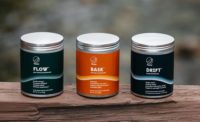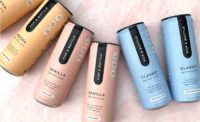Better-For-You Beverages
Imbibe sees a shift towards less sweet, more fruit, vegetable and superfood-forward flavor profiles

Cava Grill beverages are more healthful, innovative and deliberate than traditional foodservice offerings. A recent menu included flavors such as Grapefruit + Mint Raspberry Shrub; Ginger + Lime Turmeric Tonic; Carrot Ginger Lemonade; and Strawberry Mint Lime Juice.
PHOTO COURTESY OF CAVA GRILL (WWW.CAVA.COM)
Developing beverages for foodservice establishments makes up a large portion of the business at Imbibe, so in some cases, we know what’s coming to market. Imbibe also watches what’s happening in the rest of the marketplace—both in foodservice and retail—to monitor new product launches, novel ingredients and trending flavors.
While there is plenty of indulgence available in foodservice, Imbibe especially has been focused on the disruptive, health-focused, and fast-casual restaurant brands. As a society, we are in the process of shifting towards less sweet, more fruit, vegetable and superfood-forward flavor profiles. Many brands have responded by offering better-for-you beverages, and below is a brief overview highlighting some beverage menus worth knowing about:
Cava Grill
Leaders at this Bethesda, Md., chain raised $60 million prior to 2017 to expand this fast-casual Mediterranean brand beyond its current locations. In early 2017, there were 27 locations primarily in the Northeast and Southern California. As of summer 2018, there were at least 58 locations, with the promise of several more opening soon.
Cava Grill is sometimes referred to as “Chipotle chic” but its founders have done enough to distinguish themselves from Chipotle. They have a wall in many of their locations highlighting the local sources of their products and also value sustainability, as evidenced by their compostable cups.
In terms of their beverage offerings, they’re much more healthful, innovative and deliberate than traditional foodservice beverages—and Cava Grill offerings are seasonal. A recent menu included the following items: Grapefruit + Mint Raspberry Shrub; Ginger + Lime Turmeric Tonic; Carrot Ginger Lemonade; Strawberry Mint Lime Juice; Unsweetened Black Tea; and Hibiscus Green Tea. Their menu frequently features trending ingredients and categories, such as botanicals (ginger, mint, hibiscus, turmeric), vinegar, (mint raspberry shrub), and twists on classics (the veg-centric carrot ginger lemonade).
Mixt
San Francisco-based Mixt (Good Food Guys Hospitality Group), is a 13-location regional chain, with nine locations in the Bay Area. Mixt prioritizes healthy eating, local sourcing, and beyond that—officials say they strive to make being healthy “convenient.” The main beverage highlights are a kombucha on tap (which Imbibe predicts will increase tremendously in the foodservice space) and Mint Limeade. The Mint Limeade is sort of a throwback, a twist on the nostalgic lemonade/limeade family.
Ingredients that are less well known, however, aren't deterring customers from trying those ingredients, or the dishes that feature them, especially if there are benefits associated with them.
LYFE Kitchen
Memphis, Tenn.-based LYFE Kitchen has several diet-specific menus, in addition to some interesting beverage offerings. One line of offerings is called Lyfe Waters, even though they have many ingredients beyond just water (also observed at retail). Consumers can actually see botanicals, veggies, and/or superfoods suspended in these enhanced waters.
Their menu also touts their own twist on lemonade, the most recent of which was a Ginger Pomegranate version. They also offer a veg-centric smoothie, and a more traditional banana-forward blended beverage.
Native Foods Café
This Chicago-based chain boasts an entirely plant-based menu and not a super robust beverage program, but a winter visit yielded an interesting discovery: Superfood Hot Chocolate. Many Chicagoans are probably thankful that it’s not still cold enough to justify hot drinks, though this sweet and heat beverage provided warmth beyond the temperature (with turmeric, matcha and cinnamon).
Superfood beverages satisfy many consumers’ needs and wants. Many still feel indulgent with a creamy mouthfeel, while often being rich in vitamins and minerals that may have anti-inflammatory properties. Imbibe has been watching superfood lattes for a couple of years now, so we predict that there will be more brands offering superfood hot chocolates and superfood hot ciders.
True Food Kitchen
True Food Kitchen, Phoenix, has gained quite a following (more than 86,000 followers on Instagram) and has earned attention for its health-driven seasonal menu, which includes some innovative beverage offerings. They offer Honey Lemonade that consumers can customize further by adding matcha or cucumber.
Their beverage menu features several common botanicals—including mint, lemongrass, ginger—and at least one lesser known botanical: sea buckthorn. True Food Kitchen’s menu doesn’t broadcast the functional benefits, which may include relieving arthritis pain, improving blood pressure and lowering cholesterol. Ingredients that are less well known, however, aren’t deterring customers from trying those ingredients, or the dishes that feature them, especially if there are benefits associated with them.
In summary, it’s worth calling attention to these beverage menus in particular, because many of these offerings are stunning or colorful, thus making them super-Instagrammable, and shareable. This is an obvious benefit to a brand. If your followers can see something beautiful and exclusive (bonus if it’s healthy, though indulgence in moderation is also a trend), they’re going to want to know how they can also take pretty a picture.
Unsurprisingly, production value plays a huge role in foodservice beverages. There are a variety of different ways to enhance a beverage to make it more visually arresting or appealing. In 2016, there was the “freakshake” (a.k.a. overstuffed shakes with extravagant garnishes like churros, donuts, cookies, cakes and candies decorating the overflowing milkshake). #Latteart has more than 5 million posts on Instagram. Starbucks’ Unicorn Frappuccino sold out after four days and was trending on twitter.
What this tells us is that it’s about the beverage experience. Whether it’s healthful or indulgent, colorful, layered, displays gradients or the ombré effect, or elicits some amount of DIY, consumers have more interaction than ever with what they eat and drink, and their relationship with a beverage may go far beyond simply taking a sip.
Originally appeared in the August, 2018 issue of Prepared Foods as Better-For-You Beverages.
Looking for a reprint of this article?
From high-res PDFs to custom plaques, order your copy today!





